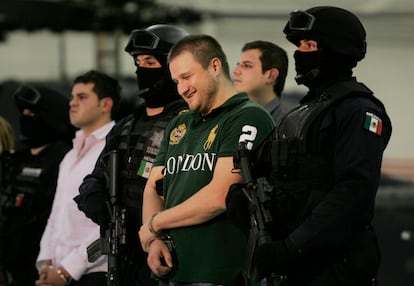Mexico asks US for answers as notorious drug lord ‘La Barbie’ vanishes from federal prison system
The Beltrán Leyva Cartel hitman, one of the most bloodthirsty narcos in Mexican history, was serving 49 years in Florida but is no longer registered as being in US custody

The whereabouts of Édgar Valdez Villarreal, alias “La Barbie,” one of the most bloodthirsty drug-traffickers in Mexican history, is unknown. The cartel chief does not appear to be in the custody of the United States Federal Bureau of Prisons (BOP), where he is serving a sentence running until 2056, as an EL PAÍS search of the database records of all inmates within the system has confirmed. A lack of official information as to Valdez Villarreal’s current status has seen his name back in the headlines, more than a decade after he was arrested in August 2010.
“There are a number of reasons why an inmate may be listed as ‘not in the custody of the Bureau of Prisons,’” a spokesperson for the US corrections agency tells EL PAÍS. “Inmates who were previously in the custody of the Bureau of Prisons and who have not served their sentence may be out of custody for a period of time to attend court hearings, receive medical treatment or for other reasons. We do not provide specific information about the status of prisoners who are not in the custody of the Bureau of Prisons for security or privacy reasons,” he adds. Until he vanished from the system, Valdez Villarreal had been serving his sentence in the Coleman II high-security penitentiary in central Florida.
The Mexican Attorney General’s Office and Secretariat of Foreign Affairs have both also confirmed to this newspaper that they also have no knowledge of La Barbie’s legal situation. One of the lawyers who represented the drug lord in court in Atlanta, Georgia, where Valdez Villarreal was sentenced in June 2018, gave no comment, arguing that he did not know why his client’s name does not appear on the BOP registry of inmates in the US federal prison system.
The US Embassy in Mexico has also not made an official statement. “Information is being requested,” President Andrés Manuel López Obrador said during his press conference Tuesday. “Over the course of the day or tomorrow everything will be known. Let’s not get ahead of ourselves.”
“I still do not have confirmation that La Barbie has been released; that is, he is still in custody,” added Secretary of Foreign Affairs Marcelo Ebrard.
La Barbie ‘most-wanted’
When La Barbie was arrested, it was considered to be one of the most significant blows against organized crime during the presidency of Felipe Calderón (2006-2012). “The Federal Police have captured La Barbie, one of the most wanted criminals in Mexico and internationally. The operation against his group continues,” Calderon said at the time.
The authorities had been on Valdez Villarreal’s trail for weeks and tightened their net around the capo near Mexico City. On the night of August 31, 2010, he was paraded in front of the media like a trophy, which was very much in the style of the official narrative during the early years of the so-called war on drugs. The arrest was orchestrated by Genaro García Luna, who served as Secretary of Public Security during the Calderón administration and who was arrested in Dallas in 2019 over his alleged links to the Sinaloa Cartel, former allies and later enemies of the Beltrán Leyva Cartel to which La Barbie belonged as the leader of the organization’s hitmen.
After his arrest, in which not a single bullet was fired according to contemporary news accounts, Valdez Villarreal remained defiant. He was wearing designer clothes and an expensive watch and he even smiled at the cameras. He received his nickname due to his fair complexion, blond hair and light eyes. Born in Texas, Valdez Villarreal held US and Mexican nationality. At the time of his arrest, he was 37 years old, but he already had dozens of assassinations under his belt.
Valdez Villarreal was one of the most trusted lieutenants of Arturo Beltrán Leyva, at that time the boss of bosses. As well as overseeing the cartel’s hitmen, he was in charge of collecting payments from underbosses. When the Beltrán Leyva brothers were partnered with the Sinaloa Cartel, they unleashed a war on their rivals, Los Zetas and the Gulf Cartel. La Barbie recorded video of victims being tortured and killed, a practice of which he was a pioneer but which is now the everyday standard in Mexican organized crime. When Arturo Beltrán Leyva was killed in December 2009, suspicions of betrayal from inside the cartel flourished. Valdez Villarreal fell out with the brothers of his former boss, tinting Acapulco and Cuernavaca, the “City of Eternal Spring,” with blood as around 20 corpses piled up per month.
La Barbie was one of the faces of a new generation of narcos, who alternated between violence and ostentation. He owned luxury properties across Mexico, drove expensive sports cars and wore designer clothes: he was also accused of money-laundering as well as drug-trafficking. His arrest in Lerma, a dormitory town in the suburbs of Mexico City, ended the myth that the capital was extent from the war on drugs and the country’s criminal topography.
Accusations of Mexico government collusion with cartels
In November 2012, two years after he was detained, La Barbie sent a letter to the journalist Anabel Hernández, which was published in Mexican newspaper Reforma, in which he claimed he had been present at meetings of drug lords personally organized by then-president Calderón. “My arrest was the result of political persecution by Mr. Felipe Calderón Hinojosa, who instigated harassment against me,” he said.
Valdez Villarreal claimed he had refused “to be part of the agreement that Mr. Calderon Hinojosa wanted to reach with all the organized crime groups.” He went on to say there had been meetings between the Mexican authorities and the leaders of the Familia Michoacana, Los Zetas and the Sinaloa Cartel, as well as with Joaquin “El Chapo” Guzmán himself. Jesús “Rey” Zambada, brother of Sinaloa Cartel leader Ismael “El Mayo” Zambada, would make the same allegations of cooperation between the authorities and the cartels years later in a US court.
Regarding Garcia Luna, La Barbie wrote: “I know for a fact that he has received money from me, from drug trafficking and organized crime.” These are virtually the same allegations facing the former head of Mexico’s police force in the United States. A spokesman for the now-defunct Federal Police said at the time that Valdez Villarreal’s accusations were an attempt to discredit the authorities’ efforts to bring him to justice.
In October 2015, La Barbie was extradited to the US. Three years later, he was sentenced to 49 years in jail on charges of drug trafficking and money laundering. According to court documents, La Barbie and his lawyers said he had been an informant for the DEA between 2008 and 2010. In 2020, when accusations against Calderón resurfaced during the trial against García Luna, the former president said the accusations were false: “I acted with determination against those criminal organizations,” Calderón told reporters.
Valdez Villarreal’s grin for the cameras in 2010 is an image that has resurfaced time and again over the last 12 years, following the letter from his cell and the accusations he threw about during his trial in Georgia, and now again amid speculation as to his whereabouts. What was La Barbie smiling about? A theory being proposed in the Mexican media is that Valdez Villarreal has entered the US Federal Witness Protection Program, or that it is a purely routine matter such as a medical check-up. The government of Andrés Manuel López Obrador has requested answers from the White House over federal prisoner 05658-748 amid the latest mystery surrounding the notorious drug lord.
Tu suscripción se está usando en otro dispositivo
¿Quieres añadir otro usuario a tu suscripción?
Si continúas leyendo en este dispositivo, no se podrá leer en el otro.
FlechaTu suscripción se está usando en otro dispositivo y solo puedes acceder a EL PAÍS desde un dispositivo a la vez.
Si quieres compartir tu cuenta, cambia tu suscripción a la modalidad Premium, así podrás añadir otro usuario. Cada uno accederá con su propia cuenta de email, lo que os permitirá personalizar vuestra experiencia en EL PAÍS.
¿Tienes una suscripción de empresa? Accede aquí para contratar más cuentas.
En el caso de no saber quién está usando tu cuenta, te recomendamos cambiar tu contraseña aquí.
Si decides continuar compartiendo tu cuenta, este mensaje se mostrará en tu dispositivo y en el de la otra persona que está usando tu cuenta de forma indefinida, afectando a tu experiencia de lectura. Puedes consultar aquí los términos y condiciones de la suscripción digital.
More information
Archived In
Últimas noticias
Most viewed
- Sinaloa Cartel war is taking its toll on Los Chapitos
- Oona Chaplin: ‘I told James Cameron that I was living in a treehouse and starting a permaculture project with a friend’
- Reinhard Genzel, Nobel laureate in physics: ‘One-minute videos will never give you the truth’
- Why the price of coffee has skyrocketed: from Brazilian plantations to specialty coffee houses
- Silver prices are going crazy: This is what’s fueling the rally










































